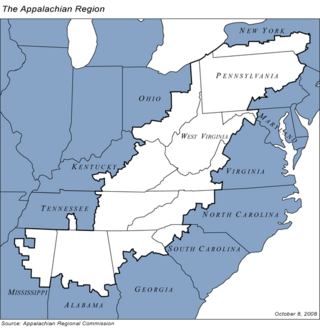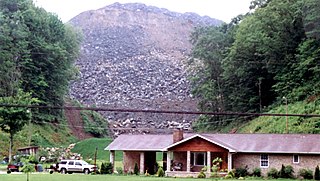Related Research Articles

Coal mining is the process of extracting coal from the ground or from a mine. Coal is valued for its energy content and since the 1880s has been widely used to generate electricity. Steel and cement industries use coal as a fuel for extraction of iron from iron ore and for cement production. In the United Kingdom and South Africa, a coal mine and its structures are a colliery, a coal mine is called a "pit", and above-ground mining structures are referred to as a "pit head". In Australia, "colliery" generally refers to an underground coal mine.

Mountaintop removal mining (MTR), also known as mountaintop mining (MTM), is a form of surface mining at the summit or summit ridge of a mountain. Coal seams are extracted from a mountain by removing the land, or overburden, above the seams. This process is considered to be safer compared to underground mining because the coal seams are accessed from above instead of underground. In the United States, this method of coal mining is conducted in the Appalachian Mountains in the eastern United States. Explosives are used to remove up to 400 vertical feet of mountain to expose underlying coal seams. Excess rock and soil is dumped into nearby valleys, in what are called "holler fills" or "valley fills".

Surface mining, including strip mining, open-pit mining and mountaintop removal mining, is a broad category of mining in which soil and rock overlying the mineral deposit are removed, in contrast to underground mining, in which the overlying rock is left in place, and the mineral is removed through shafts or tunnels.

Massey Energy Company was a coal extractor in the United States with substantial operations in West Virginia, Kentucky and Virginia. By revenue, it was the fourth largest producer of coal in the United States and the largest coal producer in Central Appalachia. By coal production weight, it was the sixth largest producer of coal in the United States.
Denise Giardina is an American novelist. Her book Storming Heaven was a Discovery Selection of the Book-of-the-Month Club and received the 1987 W. D. Weatherford Award for the best published work about the Appalachian South. The Unquiet Earth received an American Book Award and the Lillian Smith Book Award for fiction. Her 1998 novel Saints and Villains was awarded the Boston Book Review fiction prize and was semifinalist for the International Dublin Literary Award. Giardina is an ordained Episcopal Church deacon, a community activist, and a former candidate for governor of West Virginia.

Appalachian Voices is an American environmental organization. Their stated environmental concerns include eliminating air pollution, ending mountaintop removal, cleaning up coal ash pollution and promoting renewable energy and energy efficiency.

Julia "Judy" Belle Thompson Bonds was an organizer and activist from the Appalachian Mountains of West Virginia, United States. Raised in a family of coal miners, she worked from an early age at minimum wage jobs. Bonds was the director of Coal River Mountain Watch (CRMW). She has been called "the godmother of the anti-mountaintop removal movement."

Appalachia is a geographic region of the Eastern United States. Home to over 25 million people, the region includes mountainous areas of 13 states: Mississippi, Alabama, Pennsylvania, New York, Georgia, South Carolina, North Carolina, Tennessee, Virginia, Kentucky, Ohio, Maryland, as well as the entirety of West Virginia.
Arch Resources, previously known as Arch Coal, is an American coal mining and processing company. The company mines, processes, and markets bituminous and sub-bituminous coal with low sulfur content in the United States. Arch Resources is the second-largest supplier of coal in the United States, behind Peabody Energy. As of 2011 the company supplied 15% of the domestic market. Demand comes mainly from generators of electricity.
Burning the Future: Coal in America is a 2008 documentary film produced and directed by David Novack. The film focuses on the impacts of mountaintop mining in the Appalachians, where mountain ridges are scraped away by heavy machinery to access coal seams below, a process that is cheaper and faster than traditional mining methods but is damaging to the environment. Some environmental problems discussed in the film include disfigured mountain ranges, extinct plant and animal species, toxic groundwater, and increased flooding. The film's run time is 89 minutes. In 2012, it was rereleased in a shorter, updated version, that was created for public broadcast on PBS. This new version of the film's run time is 56 minutes.
Maria Gunnoe is a native West Virginian who opposes mountaintop removal mining, and is a winner of the Goldman Prize and Wallenberg Medal.
Mountaintop Removal is a 2007 documentary film directed by Michael O'Connell. The film explores how mountaintop removal mining in West Virginia has affected local communities. Filmed over a two-year period, Mountain Top Removal features community advocates, such as Ed Wiley, Larry Gibson, Julia Bonds, Maria Gunnoe, and Mountain Justice Summer volunteers, in their efforts to oppose the destruction of Southern Appalachia's natural landscape. The film includes commentary from Jeff Goodell, author of Big Coal: The Dirty Secret Behind America's Energy Future, geologists Dr. William Schlesinger and Dr. Peter Taft, and also Bill Raney, President of the West Virginia Coal Association. The film won the Reel Current Award at the 2008 Nashville Film Festival. Mountaintop Removal also received a Jury award at the 2008 Wild and Scenic Film Festival, Audience award at the 2008 Woods Hole Film Festival and was screened at The Lincoln Center on Earth Day April 22, 2008. The film is currently being distributed nationwide on PBS through NETA. The film's soundtrack includes music by Jim Lauderdale, Donna the Buffalo, John Specker and Sarah Hawker.
Mining in the United States has been active since the beginning of colonial times, but became a major industry in the 19th century with a number of new mineral discoveries causing a series of mining rushes. In 2015, the value of coal, metals, and industrial minerals mined in the United States was US$109.6 billion. 158,000 workers were directly employed by the mining industry.
Climate Ground Zero (CGZ), founded in February 2009, is a non-violent civil disobedience campaign against mountaintop removal mining based in the southern coalfields of West Virginia. According to their website, Climate Ground Zero believes “that the irrevocable destruction of the mountains of Appalachia and its accompanying toll on the air, water, and lives of Appalachians necessitates continued and direct action". The organization seeks to end mountaintop removal mining by drawing attention to the issue through protests involving trespass on the property of mining companies. By locking down to machinery on mine sites, occupying trees in the blast zone, or blockading haul roads to mine sites, protesters associated with Climate Ground Zero directly interfere with mining practices. Other protests draw attention to the alleged negligence of regulatory agencies such as the West Virginia Department of Environmental Protection (WVDEP) or the federal Environmental Protection Agency (EPA) by occupying the offices of these governmental organizations. Climate Ground Zero has been referenced in the New York Times, Los Angeles Times, Washington Post, Democracy Now, and the Associated Press.
Coal was discovered in Kentucky in 1750. Since the first commercial coal mine opened in 1820 coal has gained both economic importance and controversy regarding its environmental consequences. As of 2010 there were 442 operating coal mines in the state, and as of 2017 there were fewer than 4,000 underground coalminers.
Larry Gibson was an anti-mining environmentalist from West Virginia, who spent the majority of his adult life opposing mountaintop removal coal mining in the area, specifically at Kayford Mountain. He was president of the Keeper of the Mountains Foundation and lifetime member of the Sierra Club. He also was a board member for the Ohio Valley Environmental Coalition.
Mountain Justice is a grassroots movement established in 2005 to raise worldwide awareness of mountaintop removal mining and its effects on the environment and peoples of Appalachia. The group seeks to encourage conservation, efficiency, solar and wind energy as alternatives to all forms of surface mining. It self-describes as "a regional Appalachian network committed to ending mountaintop removal". It seeks justice because the mountaintop removal (MTR) it opposes is a form of coal mining known as mountaintop removal mining which produces coal sludge toxic waste which is stored in a dam on the mountain and leaches into the groundwater, which poisons the environment, which defaces the top of the mountain, and which is not stopped due to political corruption.

The Hobet 21 Coal Mine in West Virginia was operational between 1974 and 2015. Straddling the border of Boone County and Lincoln County in the Appalachian Mountains, the Hobet 21 mine was one of the largest mountaintop-removal coal mining operations in West Virginia. Originally owned by Fil Nutter, the mine used both underground mining and strip mining techniques, and later even more intensive surface mining using a dragline. Increasing productivity and profitability encouraged workers to successfully strike for their health plan in 1993, which resulted in unusually thorough coverage for mine workers at this time. The Hobet mine was incorporated into Arch Coal in 1997, along with several other mines, following booming coal demand. The mine was sold two more times: to Magnum Coal in 2005 and to Patriot Coal in 2008. Patriot Coal subsequently went bankrupt in 2015, and the Hobet site was passed into a Virginia-based conservation firm who continued to mine the land while reclaiming and planting trees to offset carbon emissions for other companies.

Environmental justice and coal mining in Appalachia is the study of environmental justice – the interdisciplinary body of social science literature studying theories of the environment and justice; environmental laws, policies, and their implementations and enforcement; development and sustainability; and political ecology – in relation to coal mining in Appalachia.

Environmental issues in Appalachia, a cultural region in the Eastern United States, include long term and ongoing environmental impact from human activity, and specific incidents of environmental harm such as environmental disasters related to mining. A mountainous area with significant coal deposits, many environmental issues in the region are related to coal and gas extraction. Some extraction practices, particularly surface mining, have met significant resistance locally and at times have received international attention.
References
- ↑ Mathis, Eric (August 26, 2011). "The New Face of West Virginia: Sustainability and the Importance of Creative Collaboration". Green For All.
- ↑ The Charleston Gazette (June 10, 2011).A Few Thoughts on the Last Mountain.
- ↑ "The Last Mountain (2011)". Rotten Tomatoes . Fandango Media . Retrieved July 26, 2021.
- ↑ "The Last Mountain (2011)". Metacritic . CBS Interactive . Retrieved July 26, 2021.
- ↑ Alk, Nell. "The Good Fight: "The Last Mountain"". Pomp & Circumstance.
- ↑ Schenker, Andrew (May 29, 2011). "Review: The Last Mountain". Slant Magazine .
- ↑ Schwarzbaum, Lisa (June 8, 2011). "The Last Mountain". Entertainment Weekly .
- ↑ Adams, Sam (June 2, 2011). "The Last Mountain". The A.V. Club . The Onion . Retrieved July 26, 2021.
- ↑ Catsoulis, Jeannette (June 2, 2011). "An Environmental Horror Story". The New York Times . Retrieved July 26, 2021.
- ↑ Greenberg, James (January 22, 2011). "Sundance Review: The Last Mountain". The Hollywood Reporter . Retrieved July 26, 2021.
- ↑ Koehler, Robert (January 22, 2011). "The Last Mountain". Variety .